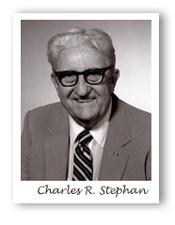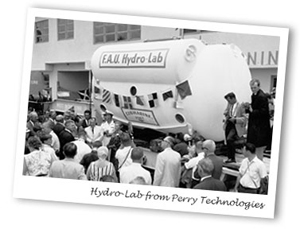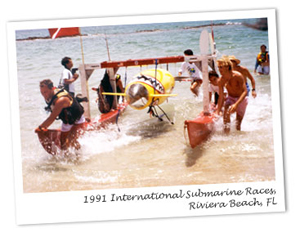History of Ocean Engineering at FAU
By Raymond F. McAllister, Ph.D., Professor Emeritus in Ocean Engineering
At a breakfast meeting in 1962, three people met to discuss a bold new program that was being proposed for Florida Atlantic University. What they discussed was an ocean-oriented specialty that would be unique and different from oceanography as offered at Florida State University, from the fisheries and oceanography program at the University of Miami, and from coastal engineering at the University of Florida. The three people at the meeting were Dr. Charles Foreman, State Board of Regents representative; Dr. Palmer Craig, proposed Dean of Science at FAU; and Mr. Gene Robinson, Assistant to the President.
Mr. Robinson was aware that Capt. Charles R. Stephan, Director of Undersea Warfare, Research and Development in the Chief of Naval Operations Office, had reported great problems with underwater equipment designed by engineers with no marine experience. Common practice was to approve designs with no more testing than operation in freshwater lakes and in test tanks. Mr. Robinson invited Capt. Stephan to the breakfast and asked him to give the group an outline of a curriculum for a program that would train engineers for ocean work. Capt. Stephan complied by giving them a proposed curriculum but thought little more about it.
Shortly thereafter, in 1963, the nuclear-powered submarine USS Thresher was lost at sea during a test dive off New England. Because information about her test depth was classified and because of great uncertainty about exactly where she went to the bottom, there was intense speculation that some of her crew might still be alive, sustained by a life support system adequate for as much as six months. She was, by any speculation, below a depth at which an effective rescue effort could be mounted. The hideous possibility of a lingering death, reported minute by minute in the world press, faced the loved ones of the crew and the people of the United States.
Mercifully, the USS Thresher was found months later in 8,400 feet of water, well below her crush depth and totally shattered by the implosion of her hull. Death had been instantaneous! The inability of the combined might of the military-industrial complex, augmented by the ocean academic community, to find her wreckage expeditiously or to be able to rescue her crew caused the United States Navy to convene the Deep Submergence Systems Review Group (DSSRG).
Admiral Ed Stephan headed the DSSRG, and one of its members was Capt. Charles R. Stephan (no relation). One of the recommendations of the DSSRG was to implement university training programs to teach engineers to work in the ocean. Mr. Robinson met Capt. Stephan in Washington and proposed that he come to Florida Atlantic University upon retirement from the Navy and start a new discipline that was to be called "Ocean Engineering." Capt. Stephan declined, saying that he did not have the academic credentials to do the job. When Mr. Robinson asked for the name of someone with such credentials who could start the new program, Capt. Stephan was stumped. He finally agreed to take the job. He was made chairman of the Department of Ocean Engineering, and our discipline was initiated. 
Planning for the new department started in 1964. Capt. Stephan, now Professor Stephan, brought aboard an oceanographer recommended by his good friend Carl Holm, who also was promoting Ocean Engineering. Dr. Ray McAllister, who had had considerable practical experience in the ocean, became the second oceaneer. Prof. Stephan and Dr. McAllister taught a course called "Introduction to Oceanography" in 1964.
In 1965 the Link Foundation made a generous grant to FAU to support the creation of the country's first undergraduate ocean engineering program. This gift was of such importance that the Foundation was recognized as one of the founders of the entire University. Established in 1953 by Edwin A. and Marion C. Link, the Foundation has long played a leadership role in supporting education and research in aeronautics and ocean engineering. Edwin Link, known worldwide as the inventor of the Link flight simulator, was a member of the DSSRG. As a result of his interaction with Capt. Stephan in this working group, he agreed to fund the earliest scholarships awarded to FAU's Ocean Engineering students. The University's close relationship with the Link Foundation lives on to this day. In 2011 the totally renovated Edwin A. Link Building at FAU's Harbor Branch Oceanographic Institute in Fort Pierce was dedicated. Additionally, Dr. Karl von Ellenrieder of FAU's Ocean and Mechanical Engineering faculty has been named program administrator of the Link Foundation's Ocean Engineering and Instrumentation Fellowship Program.
Back in the early days, Prof. Stephan got FAU's Department of Ocean Engineering started on the strength of the Link grant and money he raised from 100 presentations he made around the area. He brought aboard Dr. William Tessin, retired Director of the Navy Marine Engineering Lab at Annapolis, and Cdr. J. Blaine Davidson, a Navy acoustician recently retired as Director of Undersea Programs at the Office of Naval Research. Then several more professors joined us, and in 1965 the first class was enrolled, to graduate two years later after junior and senior years in the hard core Ocean Engineering program. They were 35 unbelievably gutsy young men who were willing to take a chance on an unknown discipline with questionable likelihood of acceptance by industry or academia.
About half of the first class was composed of young men who had read brief announcements in Skin Diver magazine about the new program and discipline. FAU started as an upper-division institution, taking students from the various junior and community colleges around the country. Their success can be seen when you look up the graduates of the Class of 1967 in the Alumni Directory. They were the first graduating class of Oceaneers in the first institution teaching Ocean Engineering anywhere in the world!
The Perry Submarine Company, now Perry Technologies, assisted greatly by giving us the "Hydrolab," an underwater habitat that we installed off Palm Beach. While only a handful of students ever used it, primarily learning how to install and recover an underwater habitat, it brought us enormous publicity. We grew rapidly and before too long had as many as 200 undergraduates enrolled. We moved out of a floor in the Library Building into six or seven locations on campus, with offices and classrooms concentrated in General Classrooms South (GCS), "Where Tomorrow Begins!"
Our first boat was a 19-foot CeeBee loaned by or leased from the Florida Ocean Science Institute. Shortly thereafter, Fred Minors, a local industrialist, gave us his 41-foot Hatteras, which we promptly renamed "Oceaneer." It was our research vessel, along with a series of 20-footers which were given to us or purchased, until Dr. Jeffrey Tennant negotiated the purchase of the trawler "Oceaneer IV."
In 1968 the National Sea Grant Office funded a program in cooperative education for the Department, and the campus-wide program grew from that beginning. We still place a couple of "co-ops" every semester. The grant provided faculty and funding for equipment and expenses and put the new department on a solid financial footing. By the grace of God and a number of outstanding chairmen, we have stayed that way.
At one point in our history we asked for a College of Engineering to be established and were told there was no chance. We were strongly advised to unite with the College of Science or we might not survive. The faculty voted to hold out, and a few months later we had a College of Engineering, and split off the beginnings of the Mechanical and Electrical Engineering Departments.
In 1973 we met the requirements of the Engineering Council for Professional Development (ECPD) and were accredited. Sometime thereafter the Accreditation Board for Engineering and Technology (ABET) took over these duties and we have been continuously accredited since 1973. The other departments in the College of Engineering also have enjoyed continuous accreditation since this initial eligibility.
At another bleak point in our funding picture, we were designated a Program of Distinction by the State University System, which carried with it extra funds and a faculty position in perpetuity. Such recognition (we were one of five Programs of Distinction in the State) and the ever-increasing acceptance by industry and government of our graduates have, in a phrase borrowed from Willard Bascom, "kept the rest wallowing in our wake."
The University began a selective freshman program in 1984, and we got rather more than our share of them. In the fall of 1983 we began our Ph.D. offering, graduating our first Doctor of Ocean Engineering in 1987. This individual, Sin Young Kang, was also the first person to earn a Ph.D. university-wide. A second and third doctoral candidate successfully completed the program in 1988. Since then we have had a large number of additional Ph.D. graduates.
In 1983 we finally got a new Engineering Building, which was already too small the day we moved in, but was an enormous improvement over the scattered broom closets we had been occupying. After Electrical and Computer Engineering moved into the Science and Engineering Building that opened in 1994, we expanded into every available space in the "old" Engineering Building. In 1999, we moved to the newly established SeaTech ocean engineering research center in Dania Beach, about 40 minutes south of the Boca Raton campus. This sophisticated facility, located between the Intracoastal Waterway and the Atlantic, provides students and faculty with direct ocean access. A great deal of important research is taking place there, including continued work on the development of autonomous underwater vehicles (AUV) and a federally funded project that is aimed at harnessing the power of the Gulf Stream and Florida's other offshore currents to generate energy.
Our student body is quite international. We have had undergraduates and graduate students from Brazil, Canada, China, France, Greece, India, Jamaica, Japan, Korea, Mexico, the Netherlands, Norway, Pakistan, Saudi Arabia, Scotland, Taiwan, Trinidad, Venezuela and other foreign countries. Very often they come to FAU because they have heard of our outstanding OE program from industrial and military figures who know of the reputation our graduates have earned for us.
In 1989, the H.A. Perry Foundation, Inc., and our department sponsored the first International Submarine Race in the waters off Riviera Beach, Florida. It was for human-powered, two-person wet subs, with no backup power systems allowed. This race was followed by two more in 1991 and 1993, both won, very handily, by the FAU-Boat, which soundly trounced our competitors in the speed category, which, after all, is what a RACE is all about!
In 1994, the FAU-Boat competed in the West Coast Submarine Invitational meet in the Offshore Model Basin in Escondido, California. There, we achieved a speed .49 knots faster than the new "fastest" boat. We made national television with that effort, mounted entirely by our students. 
Over the years the location of the race has changed, along with the name of our entry. In July 2011, FAU's Talon 1 achieved the top speed of 6.814 knots in the 11th International Submarine Race in the David Taylor Model Basin at the U.S. Naval Surface Warfare Center in Carderock, Maryland. The FAU team won the Absolute Speed Award, the Fastest Speed by Category Award (one-man propelled), the Smooth Operator Award and the Overall Performance second-place award. For more information on the International Submarine Races, visit www.isrsubrace.org.
In 2009, the College of Engineering and Computer Science was reorganized, and Ocean Engineering and Mechanical Engineering were merged into one department. OE faculty members and students carry out millions of dollars' worth of sponsored research each year, much of it funded by the U.S. Navy. Ocean engineering research is typically involved with determining innovative solutions to challenging problems in working in the ocean environment. Current projects include studies of seawater corrosion and marine materials, underwater acoustics, acoustic imaging and communication, flow noise, autonomous marine vehicles and control, hydrodynamics and propulsion of marine vehicles, physical oceanography, fabrication of nano-materials, ocean energy technologies and machine monitoring. A significant portion of the research is in the area of naval engineering. An important traditional aspect of the department's research has been the development of ocean technologies, including autonomous underwater and surface vehicles, air-deployable buoys, sonar systems, acoustic modems and a spar platform. SeaTech, the department's institute for ocean and systems engineering, serves as a means to promote transition of ocean technologies to industry.
In the 21st century, FAU's OE program continues to prosper and grow. Thanks to the accomplishments of its alumni and dedicated faculty, the reputation of this program is very well established. Every day we face new challenges centered on bringing the strengths of new technologies into the discipline while keeping the fundamentals of ocean engineering intact. We look forward to working with new classes of ocean engineers to stay in front of the pack and continue to deserve our reputation as the "Best Damn Ocean Engineering Program in the World!" For more information on the program, visit ome.fau.edu.